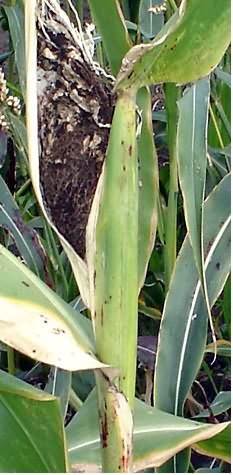Diseases
Sorosporium reilianum (Kuhn) Mc. Alpine f. sorghi Geschele - Head Smut of Sorghum
Systematic position.
Kingdom Fungi, phylum Basidiomycota, class Ustilaginomycetes, order Ustilaginales, family Ustilaginaceae, genus Sorosporium.Synonyms.
Cintractia reiliana Clinton, Sphacelotheca reiliana Clinton.Biological group.
Heterotroph.Morphology and biology.
The Head Smut of Sorghum is caused by the fungus S. reilianum which forms both teliospores (hibernating stage of the pathogen) and sporidia in its life cycle. Spherical, roundish, angular, ellipsoidal, always setaceous, tinted, 12.1 to 13.7 mkm in diameter teliospores are gathered in easily disintegrating glomerules. They sprout into three or five-celled basidia with laterally and apically growing sporidia. The sporidia are spindle-shaped or oblong, 3.2 to 10.3 mkm in size, with multicellular mycelium. The disease demonstrates diverse symptoms of affection of inflorescences (completely or partly), leaves and stalk, causing inflorescence prolification and leaf rosette. During the stage of panicle emergence, infected plants produce from their flag leaf sheath smut sori reaching 10-15 cm in size and covered with light gray capsule. The disease manifests stripes of various lengths on leaves and stalks, at first whitish and later turning black. Prolification (turn of glumes into leaflike formations) is also observed. The infection takes its origin from infected ground and seeds. Plant infection occurs mainly during seed germination, sometimes at later stages of plant development.Distribution.
The Head Smut of Sorghum was found in Russia for the first time in 1911. Now the disease affects sorghum and Sudan grass everywhere in the former USSR territories except for the Baltic States.Ecology.
S. reilianum is capable to develop at temperatures 14 to 36°C. Soil temperature 18-23°C and soil humidity 15-20% are optimal for seed infection during germination.Economic significance.
The pathogen affects plant growth and development adversely. Grain yield losses show good correlation with percentage of the disease distribution in fields. Green fodder yield loss reaches 19-34%. Control measures include crop rotation, cultivation of resistant varieties and hybrids, seed treatments before sowing.Reference citations:
Doshimov U.D. 1982. Sorghum smut fungi. Tashkent: Fan, 68 p. (in Russian).Gutner L.S. 1941. Smut fungi. M., 383 p. (in Russian).
Silaev A.I. 2005. Biological and toxicological substantiation of adaptive protection of sorghum from smut diseases in the Volga Region. PhD Thesis. St.Petersburg: VIZR, 47 p. (in Russian).
Yachevskii A.A. 1917. The yearbook of the data on diseases and their damage to cultural and wild-growing useful plants. 1911-1912. Petrograd, 463 p. (in Russian).


